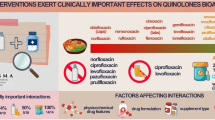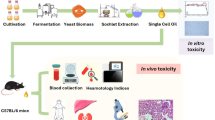Abstract
Purpose. The study examined the gastrointestinal (GIT) toxicity effects of suspensions of encapsulated and unencapsulated ibuprofen in male Wistar rats.
Methods. Rats were randomly divided into four experimental groups and four control groups, and dosed with suspensions of encapsulated and unencapsulated ibuprofen (17 mg/kg and 44 mg/kg). Bethanechol chloride, a cholinomimetic agent (5 mg/kg), was administered 30 minutes after the dosing, to induce gastric irritation. Blood plasma concentrations were monitored in another set of rats for 12 hours using the encapsulated and unencapsulated systems, to establish drug release and exposure to the mucosa.
Results. Evaluation of the upper GI segments after 7 hours revealed that the 44 mg/kg dose of the encapsulated drug significantly reduced the number of lesions present compared to the unencapsulated drug (p < 0.05). At 17 mg/kg, the encapsulated drug reduced toxicity, but not significantly compared to the unencapsulated ibuprofen. Necrosis of the mucosa was observed histopathologically in the unencapsulated drug at both doses, whereas the encapsulated drug treatment revealed preserved mucosa. The encapsulated system had a maximum plasma concentration, Cmax, and time taken to reach Cmax, (Tmax) of 26.7 µg/ml ± 1.5 and 3.6 ± 0.2 hr, respectively. The area under the plasma concentration-time curve, (AUC0–12), was 158.8 ± 23.5 µg·h/ml, confirming drug release and absorption.
Conclusions. Encapsulation of ibuprofen significantly reduced gastrointestinal toxicity especially at the higher dose level and drug was released enough to subject the GI mucosa to irritation, but without the usual toxic effects.
Similar content being viewed by others
REFERENCES
S. S. Adams, K. F. McCullough and J. S. Nicholson, The pharmacological properties of ibuprofen, antiinflammatory, analgesic and antipyretic agent. Arch. Int. Pharmacodyn. Ther.,178:115–129 (1969).
D. R. Robinson, Management of gastrointestinal toxicity of nonsteroidal anti-inflammatory drugs during the therapy of rheumatic diseases: The rheumatologist perspective, The Amer. J. Med.,84:(suppl, 2A) 1–14 (1988).
C. M. Adeyeye and J. C. Price, Development and evaluation of sustained release ibuprofen-wax microspheres: I. Effect of formulation variables on the physical characteristics, Pharm. Res.,8(11):1377–1383 (1991).
C. M. Adeyeye and J. C. Price, Development and evaluation of sustained release ibuprofen-wax microspheres: II. In vitro Dissolution Studies, Pharm. Res.,11(4):575–579 (1994).
Notes and News, Lancet, p 527, August 27 (1983).
P. B. Deasy, In “Microencapsulation and Related Processes,” Marcel Dekker Inc., New York (1984).
K. D. Rainsford, Comparison of the gastric ulcerogenic activity of new nonsteroidal anti-inflammatory drugs in stressed rats. Proceedings of the British Pharmacological Society, 226–227P (1980).
K. D. Rainsford, Gastric ulcerogenicity of nonsteroidal anti-inflammatory drugs in mice with mucosa sensitized by cholinomimetic treatment. J. Pharm. Pharmacol.,39:669–672 (1987).
A. Fujii, N. Kuboyama, S. Kobayashi, Y. Namiki and T. Tamura, Time-course study of gastric damages in rats by anti-inflammatory drugs using gastroscope and its quantification. Japan. J. Pharmacol.,48:317–322 (1988).
S. Leyck, N Dereu, E. Etschenberg, M. Ghyczy, E. Graf, J. Winkelman and M. J. Parnham, Improvement of the gastric tolerance of nonsteroidal anti-inflammatory drugs by polyene phosphatidylcholine (phospholipon® 100). Eur. J. Pharm.,117:35–42 (1985).
R. Mehvar, F. Jamali and F. M. Pasutto, Liquid Chromatographic Assay of Ibuprofen Enantiomers in Plasma, Clinical Chemistry. 34(3):493–496 (1988).
A. Slomiany, B. L. Slomiany and M. J. Horowitz, Studies on changes in lipid profiles of the rat gastric mucosa with stress ulcers. Clin. Chim. Acta 59:215–226 (1975).
K. D. Rainsford and M. W. Whitehouse, Gastroprotective and anti-inflammatory properties of green lipid mussel (Perna canaliculus) preparation. Arzneim-Forsch.,30:2128–2132 (1980b).
Rights and permissions
About this article
Cite this article
Adeyeye, C.M., Bricker, J.D., Vilivalam, V.D. et al. Acute Gastrointestinal Toxic Effects of Suspensions of Unencapsulated and Encapsulated Ibuprofen in Rats. Pharm Res 13, 784–793 (1996). https://doi.org/10.1023/A:1016068104462
Issue Date:
DOI: https://doi.org/10.1023/A:1016068104462




